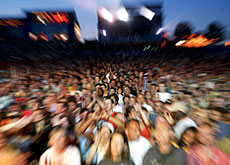
Summer festivals weather economic storm

Switzerland’s open-air festivals are gearing up for another sizzling summer, with advance tickets sales having already broken all records.
Organisers say the recession has done nothing to dampen the enthusiasm of music fans. The only barrier to growth is the lack of infrastructure.
Having weathered numerous financial roller coasters during the 1970s and 1980s, Switzerland’s music events industry has turned more professional.
Festival managers cultivate a broad network of industry contacts and sponsors, and keep a close eye on the bottom line.
The one thing that is beyond their control is the weather. But even here, the risk factor is limited as many of the tickets are sold in advance.
Switzerland probably has the highest concentration of open-air festivals in Europe. But the proliferation of events does not seem to have created any major rivalries.
“There’s still enough room for all the festivals,” says Jacques Mennier, head of programming at the Paléo festival in Nyon.
With 200,000 spectators, the Paléo, which caters mainly to pop and rock fans, is Switzerland’s biggest music event and ranks as one of the top five in Europe.
Music mix
But even though there may be enough room for all the festivals, the same cannot be said for spectators.
By mid-May – just a few days after concert tickets went on sale – three out of the six days of the Paléo were sold out.
The same goes for the Montreux Jazz festival, where several nights are already fully booked.
“It’s interesting that all the musical events have the same degree of success – from jazz, pop, rock, soul, hip-hop and even German music,” says spokesman Dominique Saudan.
Some of the festival organisers attribute their ongoing success to the quality of music on offer.
“Many Swiss festivals have established a strong tradition and an excellent reputation abroad,” Mennier believes.
Contrary to expectations, the economic downturn seems to have played into the hands of events managers, with many Swiss and Europeans holidaying closer to home.
“There’ve been a lot of tense moments [in the world] during the last twelve months,” says Saudan. “And people now just want to have fun.”
Crowd pleasers
Even the smaller festivals are faring well. The open-airs in St Gallen, Gurten, Zofingen, Gampel and Avenches each pull in crowds of between 30,000 and 50,000.
The newer festivals, such as Live at Sunset in Zurich, have also rapidly established a loyal following and are managing to draw in some top acts.
Even classical music is proving to be a crowd pleaser. Over 50,000 spectators flocked to see a mammoth production of Verdi’s opera, “Aïda”, staged for two nights at Basel’s football stadium.
As if that weren’t enough, there are also the free festivals organised by regional authorities, such as the Fête de la Musique in French-speaking Switzerland and Zurich’s Latino music event, Caliente, both attended by several hundred thousand music fans.
No venue
But despite strong ticket sales, events organisers bemoan the lack of venues for cultural events in Switzerland.
“Compared with other countries, there’s a real shortage of stadiums to host these large events,” says André Béchir, head of Goodnews, Switzerland’s biggest festival and concert organiser.
Béchir also laments the fact that the four new stadiums built for the European football championships in 2008 are not versatile enough to host non-sporting events.
“The new stadiums aren’t multi-functional,” says Béchir. “They would be much more profitable if they’d been built for a range of events, such as concerts.”
Béchir says he is relieved that a new covered venue, the Hallenstadion, has finally opened its doors in Zurich, following years of wrangling.
But, he says, it’s time that authorities got wise to the social, cultural and economic importance of Switzerland’s music events.
swissinfo, Armando Mombelli (translation: Vanessa Mock)
200,000 music fans attended the Paléo Festival in Nyon in 2002.
90,000 spectators went to the Montreux Jazz Festival.
60,000 people went to the Blue Balls festival in Lucerne.
The smaller music events in Gurten, Anvenches, St Gallen and Zofingen each pulled in crowds of 30,000-50,00.

In compliance with the JTI standards
More: SWI swissinfo.ch certified by the Journalism Trust Initiative





























You can find an overview of ongoing debates with our journalists here . Please join us!
If you want to start a conversation about a topic raised in this article or want to report factual errors, email us at english@swissinfo.ch.